by Maja Trochimczyk [1]
Abstract
This article is a revised version of a paper published in Musical Quarterly in 1998, as “Górecki and the Paradigm of the ‘Maternal'” (under the author’s previous name, Maria Anna Harley). The paper examines sacred and secular aspects of Górecki’s imagery of motherhood which juxtaposes poignant representations of maternal sorrow, captured in the symbolic icon of the suffering Mother of Christ present at his Crucifixion, “Mater dolorosa,” with subtle representations of spiritual maternal power, as in the glorious O Domina nostra. Górecki’s portrayals of motherhood have nothing in common with the national myth of the heroic Polish Mother, “Matka-Polka.” His maternal imagery is distant from the conventional myth of a good mother who finds perfect fulfillment in her child and unnafected. Instead, he draws upon certain topoi from the Catholic tradition (Mary as victorious Queen and Mater dolorosa from the Stabat Matersequence) and alludes to basic emotive behavioral patterns as his contexts and inspirations. The human mother is tearful (Symphony no. 3, Ad matrem) and full of sadness (Three Songs, Symphony no. 3). The heavenly mother is an all-powerful Queen (Symphony no. 3, O Domina nostra, Totus Tuus), but also a sorrowful mother (Ad matrem, Symphony no. 3). References to the absence of the natural mother and to the eternal source of maternal grace are often juxtaposed (Ad matrem, Symphony no. 3). The repeated rhythmic patterns draw simultaneously from cultural modes of expression of grief (slow walking, crying, lamenting), comfort (lullaby, repeated vocal phrases and gestures), and religious belief (invocations and prayers, responsorial patterns).
Article
I. Outlining the Terrain
In a recent interview, when answering a question about his links to the country of his origin, Górecki compared a personal connection to one’s homeland with the power of maternal bonding: “Even though a child is cut off from the umbilical cord, it is a child of its mother, and, this is, perhaps, the strongest tie. . . There are not many ‘renegade’ children, ‘renegade’ mothers who would not admit their kinship, who would reject what is theirs by birth. . . Nobody chooses their time and place of birth.”[2]
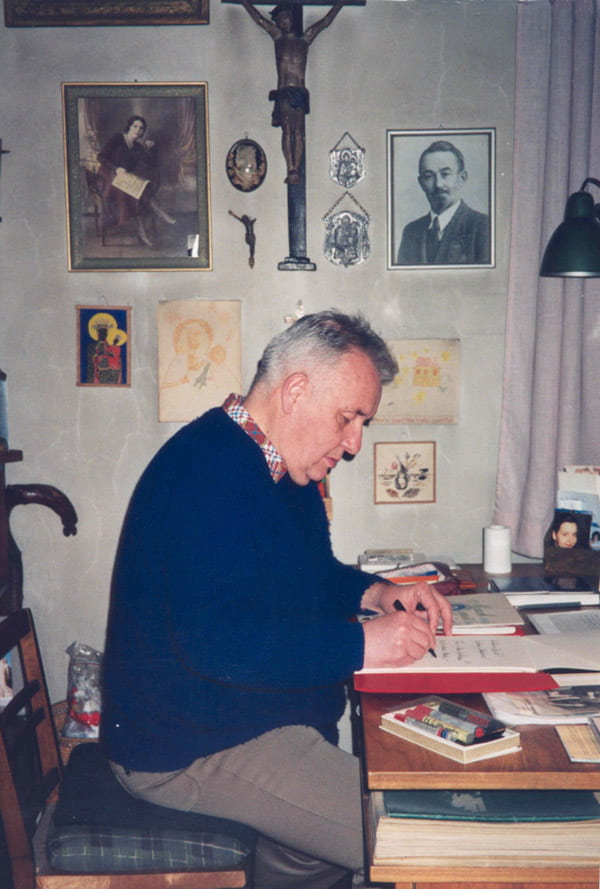
These words evoke the primordial “ecofeminist” metaphor: the earth (land, country, or region) is the mother, the human person is the child, the two are connected by the “strongest tie.” Górecki’s statements also reflect the traditional view of motherhood according to which an unbreakable bond links the “mother/child dyad” so strongly that it overwhelms the mother’s separate personal identity; by becoming a mother every woman is irreversibly transformed and all her aspirations are submerged in her “primary maternal preoccupation.”[3] The composer’s choice of the maternal metaphor as a final argument in his discussion of cultural belonging, as an image of national, regional, and personal identity, opens a new avenue for the study of his music: an examination of his use of “maternal” imagery, subjects, and myths.
An exquisitely annotated catalogue of Górecki’s works, included in Adrian Thomas’s recent monograph, enumerates all of the composer’s dedications.[4] Thomas mentions two works dedicated “to the memory of my dear mother:” Three Songs, op. 3, for medium voice and piano (composed in January 1956) and Do Matki/Ad matrem, op. 29, for soprano solo, mixed choir, and orchestra, composed over five days in June 1971. These two compositions, and the differences between the images of the maternal love arising from their texts and their musical settings, are an obvious choice for study. However, Górecki’s output includes many other pieces connected to the idea of the maternal (see Appendix 1). There are three groups of works celebrating the heavenly motherhood of the Blessed Virgin Mary, the Mother of God: (1) pieces with prayerful texts addressed to Mary, (2) Marian songs, and (3) works with references to Bogurodzica [Mother of God], a 13th-century Marian anthem. Ad matrem again appears on the list, under the first of these subheadings, and it is accompanied by Symphony no. 3, Symphony of Sorrowful Songs, op. 36, for soprano and orchestra (1976), O Domina nostra (Meditations on Our Lady of Jasna Góra), op. 55, for soprano and organ (1982, 1985), and Totus Tuus, op. 60, for mixed chorus a cappella (1987). The choral songs are a testimony to a sincere private devotion and strongly contrast with these monumental testimonials of a public religious commitment. This group consists of the Marian Songs, op. 54, for unaccompanied mixed choir (1985), Pod Twoją Obronę [Under Your Protection], op. 56, for eight-part mixed choir (1985), and some of the twenty-one unpublished Pieśni Kościelne [Church Songs] for mixed choir (1986), based on texts and melodies from Jan Siedlecki’s Church Songbook, published in 1928.[5] According to Adrian Thomas, references to Bogurodzica permeate Górecki’s output from the 1960s onwards (See Ex. 1: The first line of Bogurodzica): a “motto” motive based on the incipit of this anthem (e.g. D-E-F-E) is used in such diverse works as Songs of Joy and Rhythm (version of 1960), Symphony No. 1 (1959), Miserere op. 44 for unaccompanied mixed choir (1981), and the Harpsichord Concerto, op. 40 (1980; first movement).[6]
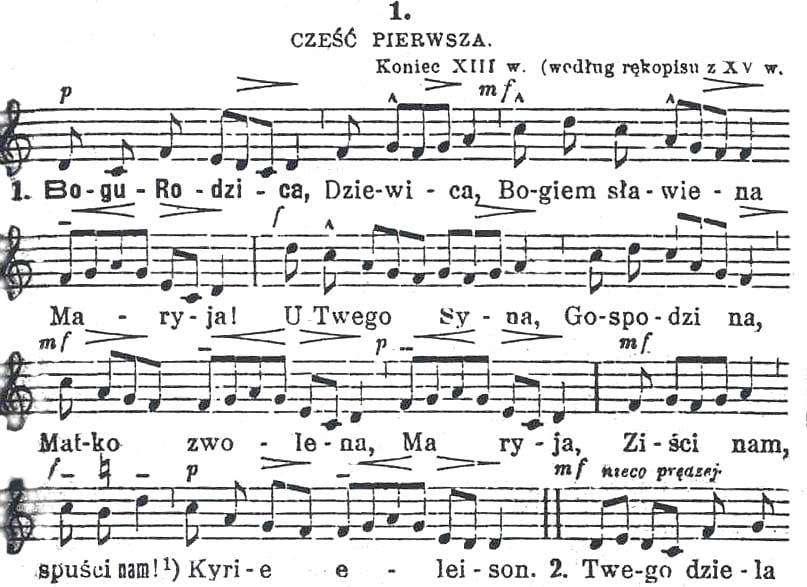
[Church Songbook] (Lwów: Wyd. Ks. Misjonarzy, 1928), 167.
After a further review of Górecki’s topics and titles, one could add his lullabies to the list of maternal-related compositions: Kołysanka [Lullaby] for piano, op. 9 (November 1956, rev. June 1980) dedicated “to Jadwiga” (the composer’s wife since 1959), Kołysanki i Tańce [Lullabies and Dances], op. 47, for violin and piano (1982; dedicated to the composer’s son, Mikołaj), and Trzy Kołysanki/Three Lullabies , op. 49 for unaccompanied mixed choir (1984). Lullabies are a particularly maternal form of music, existing in every culture; moreover, as will be shown later, their expressive and structural characteristics are significant for Górecki’s musical portrayals of motherhood.There is a range of questions about Górecki’s images of the maternal. What features of the music are used in his musical representations of motherhood, and to what effects? How is the mother portrayed? Is she an active subject, a person that develops and transforms over the duration of the work? Is she a “good” and happy mother? Do the images of motherhood have stable features in Górecki’s output, or do they evolve over the course of his career? Does he accept the models and myths of motherhood that permeate his culture? What could be said about these myths?
II. Feminist Rejection and Affirmation of the Maternal
Studies of cultural representations, models and myths of motherhood are associated primarily with the feminist movement. Radical feminist writers have been very critical of construing motherhood as a woman’s main or sole vocation.[7] One of the main difficulties that the feminists experienced with motherhood, and the reason for its rejection, was the ambiguous role of mothers in the transmission of patriarchal values and their apparent compliance with the oppression of women by social systems. Nancy Chodorow, for instance, claimed that the source of this ambiguity resided in the replication of the stereotypes of maternal behavior from one generation to the next.[8] Another group of feminist writers singled out not the biological-social constraints of motherhood as such but the myth of the “perfect mother” as the object of their criticism.[9] As a cultural construct, the maternal can be re-appropriated by authors of feminist theory; Hélčne Cixous and Julia Kristeva, for instance, used the imagery of the birthing process, the bodily states of conception and pregnancy, as well as the mother-child interaction in early post-natal stages for constructing their visions of a new, body-oriented culture.[10] In an essay entitled “Stabat Mater,” Kristeva defines the maternal as “an identity catastrophe that causes the Name to topple over into the unnameable that one imagines as femininity, non-language or body.”[11] For Kristeva, the maternal is wordless, non-conceptual, bodily, and emotional. She seeks to reaffirm the prelinguistic signification that she associates with the early stages in human development, the physical comfort and wordless emotion of mothering, or, rather, the state of “being mothered” experienced by the new-born “Other,” that is, the baby.[12] Unlike Kristeva, whose theoretical feminist writings shift the attention somewhat to the level of a pre-logocentric infant (an approach viable only for certain aspects of Górecki’s “maternal” music), American feminists tend to view the maternal from the perspective of the mother, and highly value her active role in this existential state. Sometimes the affirmation of motherhood extends into utopia: feminist theorists posit a return to the idealized societal order of matriarchy, defined as a society in which “all relationships are modelled on the nurturant relationship between a mother and her child.”[13]
However, the maternal paradigm may be positively valued even without reaching such extremes. Sara Ruddick, for instance, defined “maternal thinking” as an important type of philosophical thought, differing from all abstract systems by being “holistic, field-dependent, open-ended, not because of any innate sex differences but because that is the kind of thinking her [mother’s] work calls for.”[14] Ruddick’s maternal thinking is the “capacity for attentive love” which serves to “invigorate preservation and enable growth” of individual persons; she borrows the concept of “attention” from the philosophy of Simone Weil.[15] Attentive love is “the supreme respect and concern for all life, the fostering of the development and growth of all human beings.”[16] Both men and women may practice this form of thinking, but it arises from the existential experience of motherhood.
We will find traces of such affirmative approach in some of Górecki’s texts and his interpretations of these texts. Not that he knows the feminist writings mentioned above and accepts their statements; when hearing the first version of this paper the composer was surprised by the virulence of the feminists’ critique of the maternal and by my locating his work in this context.[17] Insights of Ruddick (maternal thinking) and Kristeva (the maternal as wordless, bodily, non-conceptual) will cast light on aspects of the Polish composer’s work. Of more importance, though, is his involvement in and relationship to images of the maternal permeating Polish culture. These myths and stereotypes differ considerably from notions put forward by the Western feminists, because motherhood is a culture-based institution. As Shari Thurer explains:[18]
Motherhood—the way we perform mothering—is culturally derived. Each society has its own mythology, complete with rituals, beliefs, expectations, norms and symbols. Our received models of motherhood are not necessarily better or worse than many others [. . .] The good mother is reinvented as each age or society defines her anew, in its own terms, according to its own mythology.
Understanding the ideals of motherhood prevalent in Polish culture is vital for the study of Górecki’s representations of the maternal. This is, though, a neglected area: in Poland the maternal mythology has not yet attracted much critical attention. For this reason, it will be useful to try to articulate some main points here.
III. Maternal Imagery in Polish Culture
My thoughts on the subject of maternal imagery are partly rooted in my personal experience: I view the Polish concept of motherhood from the double perspective of an “in/outsider,” that is, as an heir to this cultural tradition and a mother, but also as a scholar who now observes Polish culture from North America.[19] It is interesting to note that postwar Polish popular culture was characterized by a wide-spread distrust and rejection of Western feminism.[20] This phenomenon has two main roots: (1) the profound and centuries-old cultural influence of the social doctrine of the Catholic Church, created and furthered by a male-dominated and masculinist hierarchy,[21] and (2) the internalization of the socialist-government-driven critique of American feminism ridiculed by socialist propaganda as an instance of the anarchist struggle to achieve what all women could take for granted in the Polish People’s Republic, that is, gender equality in public life.[22] Even the word “feminism” has had negative connotations for many Polish speakers.[23] Only since 1989, after an open backlash against women in the workplace began,[24] have women’s “feminist-oriented” voices appeared in various publications.[25] Unfortunately, these texts often mirror Western descriptions of the role of women in a patriarchal system without addressing issues particular to Poland, such as for instance, the apparent acceptance of the status quo by women who are not perturbed by their obvious linguistic invisibility (Polish language uses masculine generics).[26]
The dominant myth of motherhood in Poland is that of the heroic figure of “Matka Polka” [Mother—Polish woman], whose work for the country is as vital as her importance for the family. The esteem for motherhood is connected with the emphasis on the mother’s achievements in preserving the Polish language and culture. This gender-paradigm arose during the years of partitions (1795-1918), when the country lost its independence and the family became “the stronghold of national identity.”[27] A nineteenth-century allegorical postcard of a woman holding the torch of light for her small children, with an explanatory caption, “Let the survivors not lose hope and let them carry the light of education for the nation,” provides the best visual interpretation of this tendency to link the maternal with the patriotic (see Figure 2 below). Thus, the maternal element in culture became particularly prominent through the emphasis on the survival and transmission of Polish cultural values in the homes. During the nineteenth century, the dividing lines in Polish society did not separate the public and the private domain into spheres of fixed gender (male and female); rather, the borderlines were drawn between the family and the community on the one hand (Polish), and the foreign state on the other (the three parts of the divided country were ruled by Russia, Prussia, and Austria).[28] Polish culture was affirmed through an allegiance to, and knowledge of, Polish language, literature, poetry, and music, all of which had a precarious status in public life and thrived in the homes. Thus, national identity was cultivated in the families; women’s special role in that process has been widely recognized.[29]
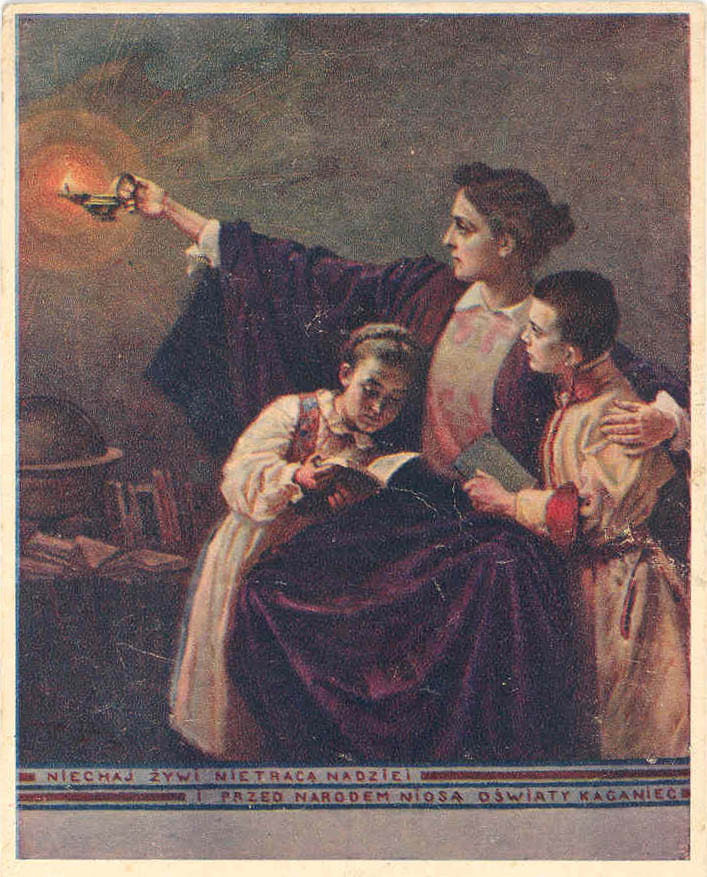
There is also a strong religious factor in the Polish vision of motherhood, based on the predominant position of Mary in the Polish form of Roman Catholicism. Unlike the Catholic churches of North America, where, under the influence of competing Protestant churches, faith in Jesus is often the sole focus of the liturgy, it is hard to find a single Mass celebrated in Poland without any Marian hymns or prayers. The religious calendar is filled with Marian holidays; she is the dedicatee of the months of May (“May services” in honor of Mary), October (the Rosary month), and December (Roraty that is, services on the theme of waiting with the pregnant Mary for the birth of Jesus). In addition, there are sixteen Marian feasts scattered throughout the Church calendar, including the Feast of the Queen of Poland which coincides with the state celebration of the May Third Constitution. In the Polish version of the popular Loreto Litany, Mary is named the Queen of Poland; her images proliferate, she is the subject of songs, poems, and popular devotions.[30] These two models of motherhood, the Heroic Polish Mother (Matka-Polka), and the Mother of God are the most important elements in the Polish concept of the maternal.[31]
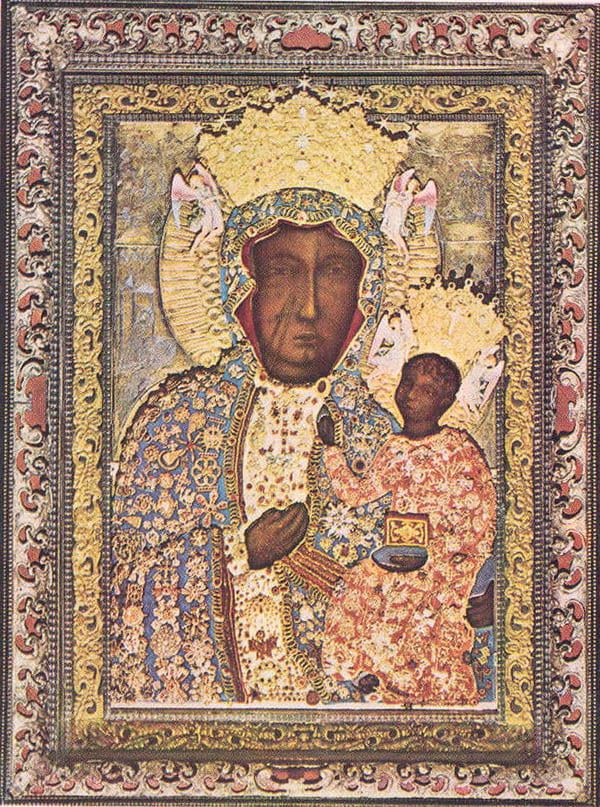
The venerated image of “Our Lady of Jasna Góra,” (Jasna Góra is a Pauline Monastery located in Częstochowa, the destination of yearly pilgrimages), presents Mary as powerful and intensely serious. This heavenly mother has captured the Polish collective imagination so completely that various copies of her image are present in most Polish homes (see Figure 3: Black Madonna).[32] The frontal position of Mary, confronting the viewer with an unflinching gaze, commands feelings of awe and respect; the scars on her cheek are a sign of suffering that she shares with her worshippers. The 13th-century Byzantine icon is very distant from nineteenth-century representations of the Blessed Virgin as a charming and subservient child-mother, looking up to the heavenly Father. However, Mary’s portrayal as silent, humble, obedient, and patiently waiting for grace frequently appears in the vast mariological literature, written almost exclusively by priests and male theologians.[33] This Mary, “the Mother of God, but not God, the Mother” has been the subject of much criticism from the Western feminists. Shari Thurer points out the emphasis on Mary’s perfect humility and warns that “there is an underside to Mary’s selflessness if we consider that Mary has no self, she has no needs of her own.”[34] This selfless Mary is “a perfect canvas for our projections;” not a real woman, but an imaginary ideal construed as a model for all mothers. Thurer suggests that while Mary is worshipped, real mothers are often objects of contempt; this duality informs the main problem with the maternal, that is its distance from, and the influence upon, real human life.[35] In Poland, such ambivalence towards Mary is uncommon. Her image juxtaposes several ideals of womanhood: a powerful, heavenly queen, a suffering mother, a perfect nurturer, an innocent virgin, a humble servant, and a superhuman being excluded from the common fate of all humans—the birthmark of original sin—by virtue of her Immaculate Conception. What aspects of this complex mosaic have captured the imagination of Henryk Górecki?
IV. Górecki’s Madonnas
While the equation of Polishness with Catholicism is an oft-repeated, though strongly contentious statement, the cultural uniformity of post-war Poland, with seriously limited minority populations of Jews, Ukrainians, Byelorussians, and Germans, has led to a prominence of Catholic symbols in the country’s social life (90 percent of contemporary Poles define themselves as Catholic).[36] Sociological studies have found that a nation’s dominant and unified religious environment affects the religious beliefs of its citizens to a much greater extent than their personal background and parental influences.[37] Therefore, the traits of the Polish brand of Roman Catholicism could be a significant factor in the formation of Górecki’s understanding of the maternal: he is a deeply devout man whose profound attachment to his faith has often been commented upon.[38] The strong adherence to Catholicism and a high degree of personal religiosity is apparent in Górecki’s public statements and aesthetic beliefs, in the choice of his texts and occasions for which he has composed music. One could mention here the commission of Beatus vir dedicated to Pope John Paul II, or the circumstances of Miserere written after clashes between Solidarity supporters and security police in Bydgoszcz.[39] Górecki’s home is filled with folk paintings and sculptures on religious themes, including reproductions of the Black Madonna of Częstochowa and folk sculptures of the “sorrowful Christ” [Chrystus frasobliwy].
His library is stocked with texts by Polish poets who express strong religious sentiments in their writings, e.g. Juliusz Słowacki, Cyprian Norwid, and Maria Konopnicka. The composer’s Christian faith is closely connected to his aesthetic creed and he is particularly fond of Andrei Tarkovski’s statement that “art is prayer.”[40] In his acceptance speech upon being awarded an honorary doctorate at the Catholic University of America in Washinton, DC, 28 February 1995, Górecki states that authentic artists know that their art is nothing else “but the reflection of God’s beauty.”[41] Many of his works explicitly focus on the sacred subject matter, particularly the devotion to Mary.
Let us first review the texts of his choral songs, including Marian Songs (1985) and Church Songs (1986), as well as Under Your Protection (1985). The last work on this list is a setting of a popular prayer addressed to Mary, the “holy Mother of God” who is the Mediatrix between the people and her divine Child. This prayer, and the remaining Marian songs, present an image of Mary as a Mediatrix, Protectrix, and Queen of a status equal to her Son. She was removed from this elevated position by the subsequent documents of the Church, including the texts of Vatican II. In Siedlecki’s Songbook, the source material for many of Górecki’s choral songs, Mary is the addressee of 80 songs (plus 20 other chants constituting parts of specific services and 8 texts without melodies). In comparison, the Songbook includes 40 songs addressed to the Most Holy Sacrament (Eucharist), 27 Lenten songs, 16 Easter songs, 15 Advent songs, and only four songs each for the Pentecost and for the Holy Trinity.
Two songs from Górecki’s Marian collection (op. 54) are addressed to “Mother of God, the Refuge of Sinners” in Siedlecki’s Songbook; the third song is a version of “Hail Mary,” the fourth expresses the pilgrim’s sorrow at leaving the sanctuary in Częstochowa, and the last one is a contemplation of her Immaculate Conception. The twenty one unpublished Church Songs include seven texts to and about Mary who should “be praised a thousand times” (no. 11) as the “Lady of the World” (no. 6) and the “merciful Mother” of all the faithful (no. 10, no. 2). She is “all-powerful in heaven and on earth” (Marian Songs, no. 1); she is worshipped for her purity exemplified in her Immaculate Conception, and for her assumption to heaven (Marian Songs, no. 5).[42] Her maternal genealogy extends to the previous generation; Górecki’s Church Songs include a setting of the only song in praise of St. Anne included in Siedlecki’s Songbook, “Welcome Lady, Mother of the Mother of Lord Jesus” (no. 5). The images of Mary appearing in these texts fuse into the figure of a powerful Queen-Mother.
The Church Songs begin with an Advent song from Siedlecki’s collection[43] (an expanded version of Hail Mary; no. 1) and continue with an explicit celebration of Mary’s motherhood which is extended, after the death of Jesus, to all believers (no. 2, “Let us go hugging, like children”). The latter song, addressed to Mary’s “heart, goodness itself” enumerates the features of her perfect motherhood: her concern for all her children, her unbounded love and forgiveness, her patience and sweet gentleness. While focusing their attention on the heavenly mother the believers express a child-like simplicity and trust in Mary’s all-embracing protection; similar feelings underlie another of Górecki’s favourite religious texts, “Already it is Dusk.”[44] According to Shari Thurer, the Blessed Virgin Mary may be described as “one of few female characters to have attained the position of archetype [. . . She is] the perfect nurturer. She stands for maternity itself.”[45] Mary ‘s right to universal motherhood is based on her suffering at the bottom of the Cross where her “heart has been pierced by the sword of sorrow” (Marian Songs, no. 2, “Most holy Mother!”; a similar phrase appears in Church Songs, no. 2, “Idźmy, tulmy się, jak dziatki”). It is her grief and co-suffering with Jesus that endows her with redemptive powers. This important image of mater dolorosa emerged in the Middle Ages; the phrase itself comes from a sequence, Stabat Mater which has been set to music by many composers, including one of Górecki’s favorites, Karol Szymanowski. Number 15 of the Church Songs, “Witaj Jutrzenko” [Hail, Morning Star], remains incomplete, probably because of its allusions to the political power of the icon of the Black Madonna of Częstochowa, an image to which all monarchs of the world were supposed to bow down.
However, the victorious Lady of the Bright Mount is a subject of Górecki’s important “public” work: O Domina nostra (Meditations on Our Lady of Jasna Góra), op. 55, for soprano and organ (1982, 1985). This composition was conceived as a celebration of the 600th anniversary of the Black Madonna. The 35-minute work is an enormous supplication and mantra-like recitation of the holy names (see Ex. 2: Text of O Domina nostra with all the repetitions). The three-part piece begins with a quiet invocation to “Our Lady” whose immense power and transcendent glory provide inspiration for the revelatory climax of the central section (“Claromontana Victoriosa Regina nostra MARIA”).[46] The overall formal outline could be described as a symmetric ABA’ form which includes an abbreviated return of the initial segment of the piece; there are eight repetitions of “Domina” in section A and five in section A’. The musical setting highlights the textual meaning by repetition: eight successive occurrences of “Domina” in the first section are followed by two repetitions of “Maria,” five of “Domina” and fifteen of “nostra.” The composer affirms the sovereign authority of Mary before naming her “our” Lady; his text also alludes to Christ-centered prayers, often beginning with the word “Domine.”
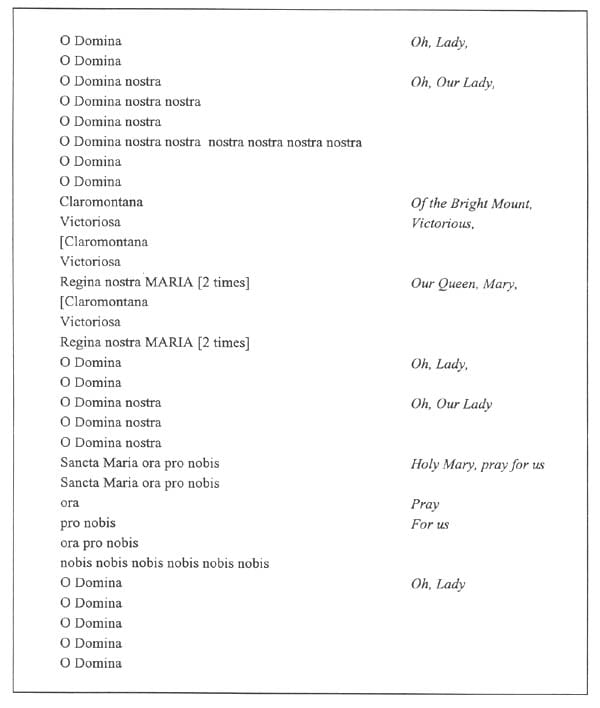
After the outburst of exultant joy in the dramatic center of the piece, the music features a prayer-like section of monotone quasi-recitation (“Sancta Maria—ora pro nobis”) followed by the tranquil, plaintive invocation, a repeated call upon the “Domina.” By its insistent recurrences the last word becomes less an assertion of the fact, than a humble request to Mary to be truly “ours” and to extend her maternal protection to all of her children. Górecki’s spelling of MARIA with upper case lettering (used in the central, dramatic section of the piece), places a special emphasis on her name; he uses similar differentiation of upper and lower case in other works, such as Totus Tuus. In this extended meditation on the mystery of the Black Madonna, her only attribute is that of victorious Queen. It is interesting to note that this attribute is assigned twelve invocations in the closing segment of the Loreto Litany, the textual model for O Domina nostra. In Górecki’s piece she is described neither as a mother (twelve invocations in the Litany), nor as a virgin (seven invocations). The final phrases quote the Loreto Litany and allude to its Polish version which includes a petition to the Queen of Poland. The connection to the Litany is established by the use of a direct quotation (“Sancta Maria—ora pro nobis” appearing twice) and the symmetrical layout of the text mirroring the responsorial form of the Litany. In the composer’s original text, printed on the first page of the score, Mary’s royal attributes are paired: “Claromontana—Victoriosa.” As in other works with brief texts, especially Totus Tuus and Ad matrem, the many symmetries in the textual source are obbliterated in the musical setting. Here, the composer highlights Mary’s sovereign ladyship, her royal power, her strength; our childlike dependence on her protection is suggested through the quiet, melodic repetitions of the word “nostra.”
Mary, our Queen, becomes Mary, the Mother of the World, in another “public” choral work, Totus Tuus [All yours], op. 60, for mixed chorus a cappella (1987), dedicated to Pope John II on the occasion of “his third pilgrimage to his homeland.” The text consists of a five-line Latin miniature by Maria Bogusławska:
| Totus Tuus sum, Maria, | I’m all Yours, Maria, |
| Mater nostri Redemptoris. | Mother of our Redeemer. |
| Virgo Dei, Virgo pia. | Virgin of God, Pious Virgin. |
| Mater mundi Salvatoris. | Mother of the world’s Saviour. |
| Totus Tuus sum, Maria! | I’m all Yours, Maria! |
The phrase Totus Tuus is the motto of Pope John Paul II to whom this work has been dedicated. Górecki focuses attention on “the Name of the Mother”—to paraphrase Julia Kristeva—that is, the dyad Maria/Mater (see Example 3: Textual repetitions in Totus Tuus). The forty repetitions of “Maria” and twenty of “Mater” are irregularly distributed through the piece.[47] The remaining words assure her of the caller’s complete, unconditional devotion: “totus tuus sum.”

Górecki tellingly alternates dramatic exclamations of the name MARIA (in upper case letters; see Ex. 4: Invocations to Mother/Mary in Totus Tuus and Ad matrem), with tender settings of descriptive phrases, defining her characteristics: “Mater nostri, Virgo Dei.” The Pope’s motto, Totus Tuus, appears in slow rhythmic figures, with the pace evocative of relaxed breathing, and with consonant harmonies of traditional hymn settings.[48] The block chords of these tranquil, pensive sections of the work contrast with folk-inspired incantations of the holy name of MARIA that begin both sections of the work (see Ex. 4). The textual repetitions highlight her maternal rather than her virginal features: she is “Mother of our Redeemer,” but primarily the “Mother of the World.” Górecki’s choice of repeated phrases pointedly focuses the listener’s attention on Mary’s universal motherhood. In each appearance of the phrase “Mater mundi Salvatoris” [Mother of the world’s Savior], “Mater mundi” is repeated three times before the word “Salvatoris” shifts the meaning. This musical interpretation of Bogusławska’s text could be translated as: “Mother of the world, Mother of the world, Mother of the world’s Savior.” The maternal appeal of Mary, who is the surrogate, perfect mother of all the faithful, knows no bounds. The work disappears into silence with twelve repetitions of her name: “Maria, Maria, Maria…”
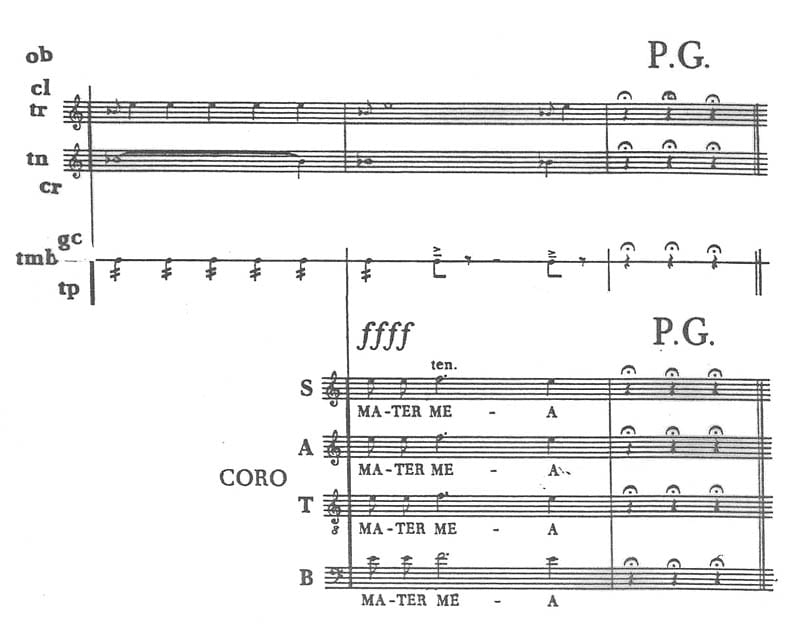
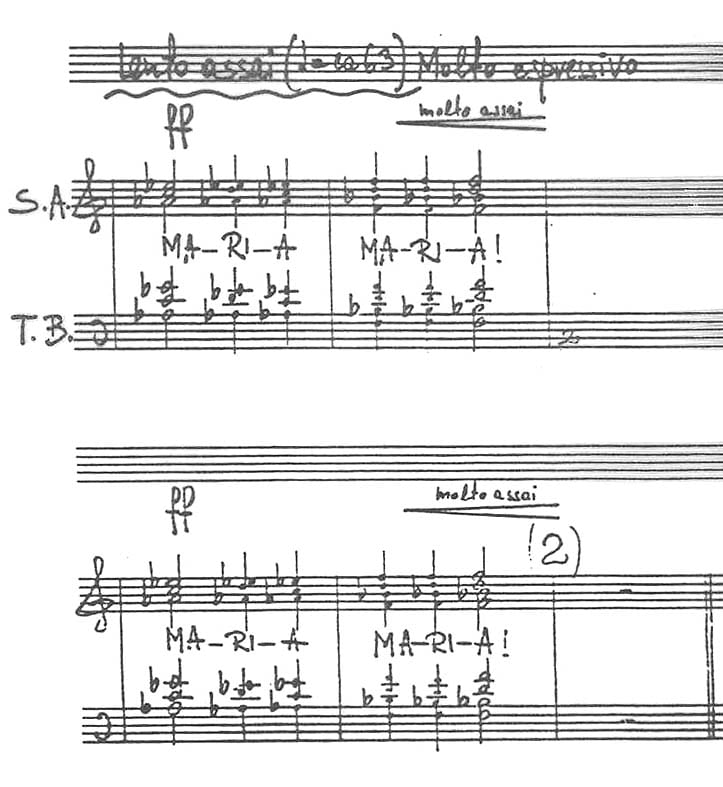
The endless recurrences of the Holy Name in both works, Totus Tuus and O Domina nostra, bring existential associations of a two-fold nature, connected to religion and maternal behaviour. The first type of gestural similarity relates the two works on “sacred” subject matter to their cultural context, that is, the use of repeated textual patterns in prayer, including the Litanies (especially the Loreto Litany as mentioned above, but also the Rosary), and the mantra-like “Prayer of Jesus” recited in the breathing rhythm of “IN—Jesus Christ, Son of God” and “OUT—Have mercy on me, a sinner.” The recitation of prayers on one tone (as in plainchant’s psalmody) is directly quoted in the section “Sancta Maria—ora pro nobis” in O Domina nostra and with the words of Hail Mary (“Zdrowaś Mario, Łaskiś Pełna”) in the second movement of Symphony No. 3.
The second type of cultural association refers to the use of repetition in the linguistic practice of very young children and in the childhood genre, the lullaby. There is an urgent need for the reassurance of love in a child’s repeated calls on mother’s name; there is a soothing tranquility in the redundancy of the excessive recurrences of the same word, nonsense syllable, or phrase in her responses, which include comforting gestures and the singing of the lullaby. It is the repetitiveness and simplicity of lullabies, noted by researchers, that distinguishes them from other types of songs.[49] Górecki’s repetitions share certain traits with the genre of the lullaby, and serve to evoke similar emotional responses. I will elaborate on this point at the end of this paper.
V. “To My Dear Mother”: Three Songs and Ad matrem
So far, we have briefly examined some of Górecki’s music with religious themes, addressed to the heavenly Queen and Mother, Mater dolorosa. These works arise from the composer’s commitment as a religious man, a son of the Catholic Church; his basic existential position, that of a son, is reflected in two compositions dedicated to his own mother. He kept an old photograph of her next to his writing desk and for years refused to repaint the studio because there was an image of a heart accidentally created on the old walls right under the mother’s portrait.
